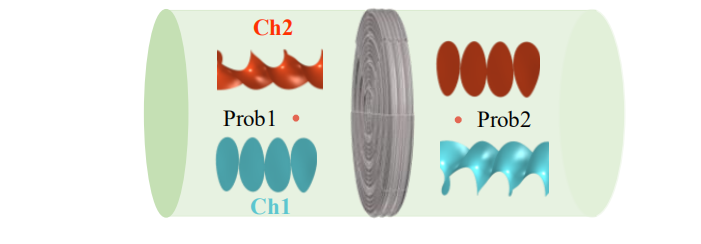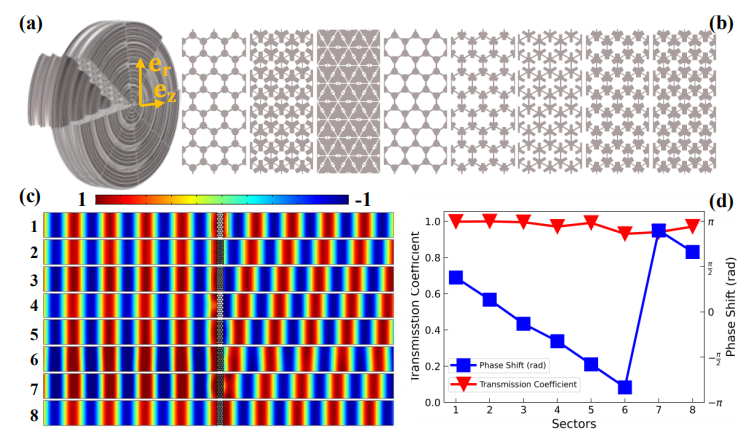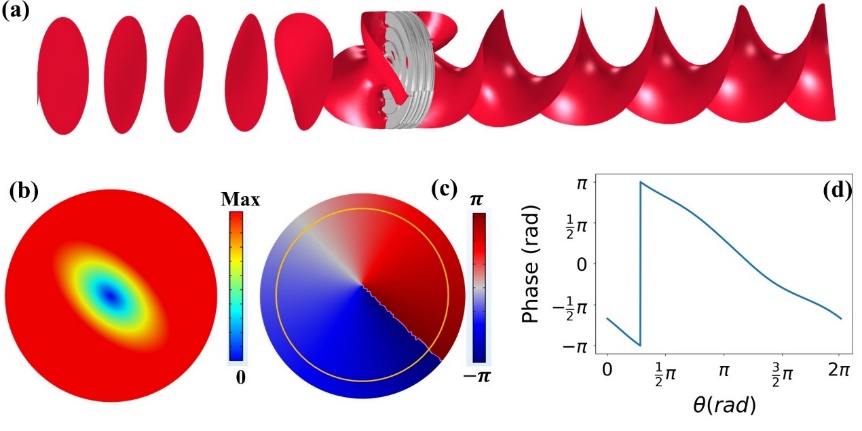As the dominant information carrier in water, acoustic wave is widely used for underwater detection, communication and imaging. Even though underwater acoustic communication has been greatly improved in the past decades, it still suffers from slow transmission speed and low information capacity. The recently developed acoustic orbital angular momentum (OAM) multiplexing communication promises high efficiency, large capacity and fast transmission speed for acoustic communication. However, the current works on OAM multiplexing communication mainly appears in airborne acoustics. The application of acoustic OAM for underwater communication remains to be further explored and studied.
Researchers from the Institute of Acoustics of the Chinese Academy of Sciences (IACAS) designed an underwater acoustic metasurface by pentamode metafluid to achieve underwater acoustic orbital angular momentum (OAM) multiplexing communication, realizing multiplexing and demultiplexing in underwater acoustic communication.
Based on the previous studies, researchers designed an impedance matching demultiplexing metasurface with pentamode materials (PM-DMM) to realize underwater multiplexing acoustic communication. In this work, the multiplexing signal was composed of plane wave (Ch1) and 1st order vortex beam (Ch2) as two independent communication channels. When the signal passed through the designed metasurface, the plane wave was converted into -1st OAM beam, and the vortex wave was converted into plane wave. By placing two probes in front of and behind the metasurface, the sound field information of Ch1 and Ch2 could be read respectively by taking advantage of the zero field in the center of vortex wave, and then the multiplexing signal could be decoded.
Researchers used the commercial finite element software COMSOL Multiphysics to carry out the acoustic simulation experiment on the designed metasurface. In the simulation, the pixels corresponding to the picture "IOA" were encoded into each channel of the multiplexing signal in the method of amplitude shift keying and phase shift keying at the same time. The multiplexing signal was transmitted in the form of pulses, in which each pulse cycle contained 2 bits data, corresponding to two pixels respectively. At the receiving end, the transmitted image could be reconstructed by reading and processing the signals of each channel.
The simulation shows the effectiveness of the system for underwater acoustic multiplexing communication. This work paves the way for experimental demonstration and practical application of OAM multiplexing for underwater acoustic communication.
The research was published online in Journal of Physics D Applied Physics.

Figure 1. Schematic representation of DMM based multiplexing communication system. (Image by IACAS)

Figure 2. (a) The PM-DMM constructed by eight sectors. (b) The cross sections of the eight sectors. (c) Simulated sound transmission field through the eight cells. (d) The transmission coefficients (marked by red triangles) and the phase shifts (marked by blue squares) of the eight cells (Image by IACAS)

Figure 3. The simulated performance of the PM-DMM. (a) A plane wave at 7100 Hz is converted to -1st order OAM beam after passing through the PM-DMM. (b) The pressure distribution of the -1st order OAM beam at z=235 mm. (c) The phase distribution of the -1st order OAM beam at z=235 mm. (d) Phase shift along the yellow circle shown in (c) with r=80 mm. (Image by IACAS)

Figure 4. Multiplexing communication with signal merged in plane wave (Ch1) and 1st order OAM beam (Ch2). (a) The received signals corresponding to the letters ‘IOA’. (b) Images independently retrieved from the received data carried by the two channels. (Image by IACAS)
Reference:
SUN Zhaoyong, SHI Yu, SUN Xuecong, JIA Han, JIN Zhongkun, DENG Ke, YANG Jun. Underwater Acoustic Multiplexing Communication by Pentamode Metasurface. Journal of Physics D: Applied Physics 54(20), 205303 (2021); DOI:10.1088/1361-6463/abe43e
Contact:
ZHOU Wenjia
Institute of Acoustics, Chinese Academy of Sciences, 100190 Beijing, China
E-mail: media@mail.ioa.ac.cn


